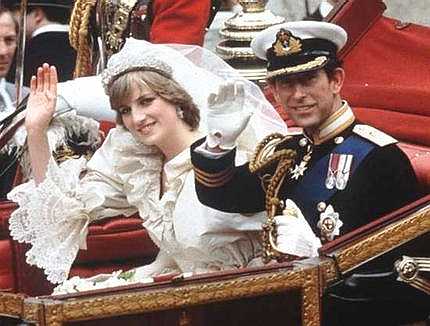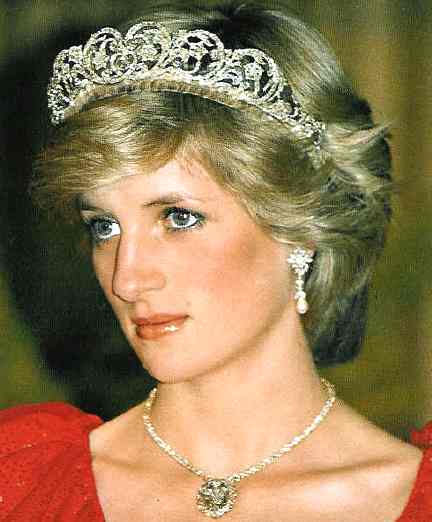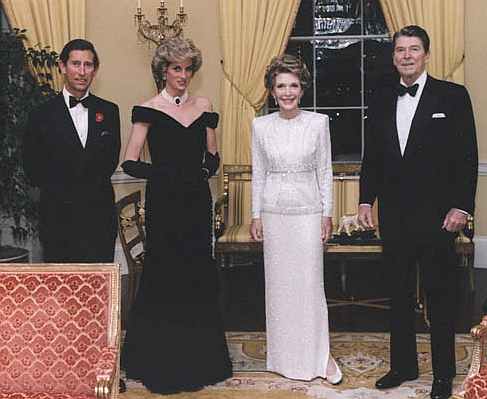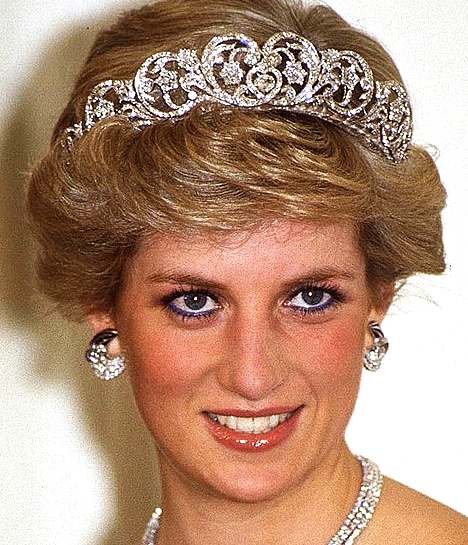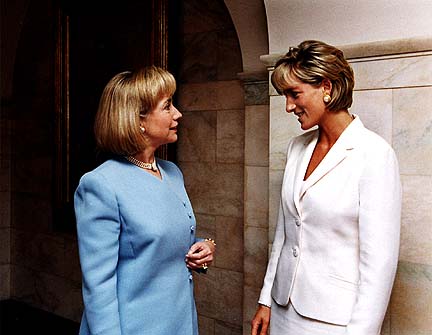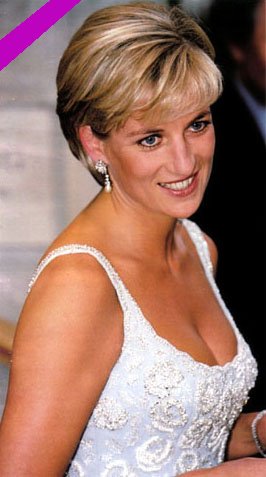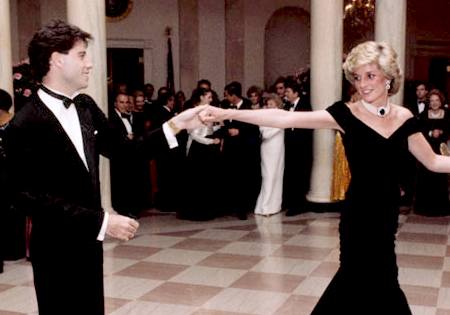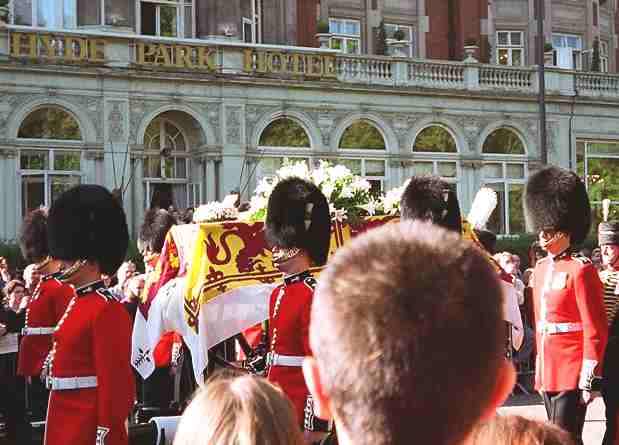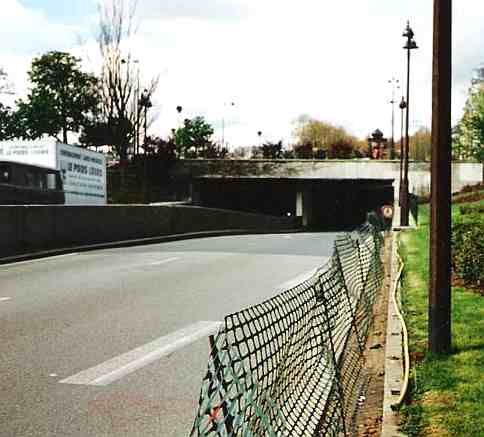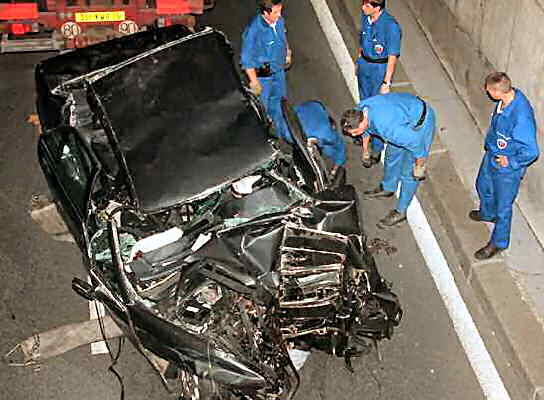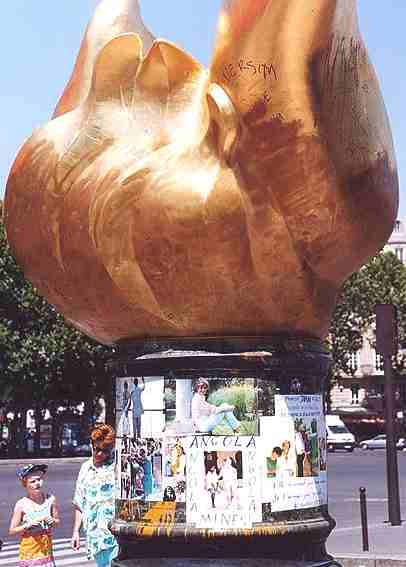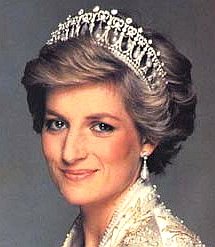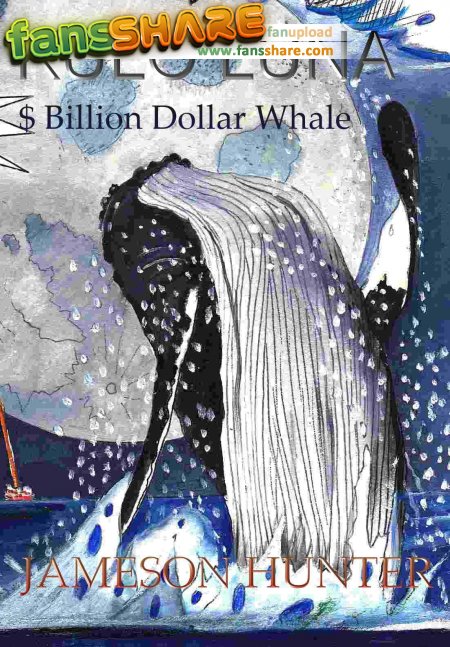|
HRH DIANA PRINCESS OF WALES
|
||||||||||||||||||||
|
HOME | BIOLOGY | FILMS | GEOGRAPHY | HISTORY | INDEX | INVESTORS | MUSIC | SPORT | ||||||||||||||||||||
|
Diana, Princess of Wales (Diana Frances; née Spencer; 1 July 1961 – 31 August 1997) was the first wife of Charles, Prince of Wales. Their two sons, Princes William and Harry, are second and third in line to the thrones of the United Kingdom and 15 other Commonwealth Realms.
The Prince and Princess of Wales return from their 1981 wedding at St. Paul's Cathedral
Early life
Diana Frances Spencer was born into the British aristocracy, the youngest daughter of Edward John Spencer, Viscount Althorp, later John Spencer, 8th Earl Spencer, and his first wife, Frances Spencer, Viscountess Althorp (formerly the Honourable Frances Burke Roche). She was born at Park House, Sandringham in Norfolk, England. She was baptised at St. Mary Magdalene Church in Sandringham, by Rt. Rev. Percy Herbert (rector of the church and former Bishop of Norwich and Blackburn); her godparents included John Floyd (the chairman of Christie's).
Diana's four siblings were:
During her parents' acrimonious divorce over Lady Althorp's adultery with wallpaper heir Peter Shand Kydd, Diana's mother took her two youngest children to live in an apartment in London's Knightsbridge, where Diana attended a local day school. That Christmas, the Spencer children went to celebrate with their father and he subsequently refused to allow them to return to London and their mother. Lady Althorp sued for custody of her children, but Lord Althorp's rank, aided by Lady Althorp's mother's testimony against her daughter during the trial, contributed to the court's decision to award custody of Diana and her brother to their father. On the death of her paternal grandfather, Albert Spencer, 7th Earl Spencer in 1975, Diana's father became the 8th Earl Spencer, at which time she became Lady Diana Spencer and moved from her childhood home at Park House to her family's sixteenth-century ancestral home of Althorp.
A year later, Lord Spencer married Raine, Countess of Dartmouth, the only daughter of romantic novelist Barbara Cartland, after being named as the "other party" in the Earl and Countess of Dartmouth's divorce. During this time Diana travelled up and down the country, living between her parents' homes - with her father at the Spencer seat in Northamptonshire, and with her mother, who had moved north west of Glasgow in Scotland. Diana, like her siblings, did not get along with her new stepmother.
Princess Diana wearing diamond tiara
Royal descent
Diana was born into an aristocratic background with royal Stuart ancestry.
On her mother's side, Diana had Irish, Scottish, English and American ancestry. Her great-grandmother was the famous New York heiress Frances Work.
On her father's side, Diana was a direct descendant of Charles II through four illegitimate sons:
She was also a descendant of James II and VII through an illegitimate daughter, Arabella FitzJames. Arabella's mother was Arabella Churchill, the sister of John Churchill, 1st Duke of Marlborough, and so she is a distant relative of Winston Churchill
Diana's other notable ancestors included Robert I (the Bruce) and Mary, Queen of Scots (an aspect of family history in which Diana expressed great interest); Mary Boleyn; Lady Catherine Grey; Maria de Salinas; John Egerton, 2nd Earl of Bridgewater; James Stanley, 7th Earl of Derby; and George Washington's brother John Augustine Washington.
The Spencers had been close to the British Royal Family for centuries; rising in royal favour during the mid 1600s. Diana's maternal grandmother, Ruth, Lady Fermoy, was a long-time friend and a lady-in-waiting to Queen Elizabeth, the Queen Mother.
Actor Oliver Platt is a second cousin, being another great-grandchild of Frances Work.
The Prince and Princess of Wales with US President Ronald Reagan and his wife, First Lady Nancy Reagan
Education
Diana was firstly educated at Silfield School in Kings Lynn, Norfolk, then at Riddlesworth Hall in Norfolk and at West Heath Girls' School (later reorganised as the New School at West Heath, a special school for boys and girls) in Sevenoaks, Kent, where she was regarded as a poor student, having attempted and failed all of her O-levels twice. In 1977, at the age of 16, she left West Heath and briefly attended Institut Alpin Videmanette, a finishing school in Rougemont, Switzerland. At about that time, she first met her future husband, who was dating her sister, Lady Sarah. Diana reportedly excelled in swimming and diving and is said to have longed to be a ballerina but did not study ballet seriously and was too tall for such a career at 5'10".
Once it was clear that she would not earn any formal educational qualifications, Diana begged her parents to allow her to move to London, a request granted before she was seventeen. An apartment was purchased for her at Coleherne Court in the Earls Court area, and she lived there until 1981 with three flatmates. During that period, she studied for a Cordon Bleu cooking diploma, although she apparently hated cooking, and worked at Madame Vacani's Dance Academy in Kensington, but resigned because she didn't like the pushy stage school parents. Lady Diana filled time as a cleaner and a cocktail waitress, before finding a job as a part-time aide at the Young England Kindergarten nursery school.
Marriage
Prince Charles' love life had always been the subject of press speculation, and he was linked to numerous glamorous and aristocratic women. In his early thirties, he was under increasing pressure to marry. Legally, the only requirement was that he could not marry a Roman Catholic; a member of the Church of England was preferred. In order to gain the approval of his family and their advisers, any potential bride was expected to have a royal or aristocratic background, as well as be Protestant. Diana seemed to meet these qualifications. They married at St Paul's Cathedral on 29 July 1981, watched by a global audience of almost one billion.
Dianna Princess of Wales
Separation and divorce
In the late-1980s, the marriage of Diana and Charles fell apart, an event at first suppressed, then sensationalised, by the world media. Both the Prince and Princess of Wales allegedly spoke to the press through friends, each blaming the other for the marriage's demise. Charles resumed his old, pre-marital affair with Camilla Parker Bowles, while Diana had an affair with her riding instructor, James Hewitt. She later confirmed the affair with Hewitt in a television interview with Martin Bashir for the BBC programme Panorama. Charles had confirmed his own affair over a year earlier in a televised interview with Jonathan Dimbleby. Although no charges were ever considered, adultery with the Queen consort or Princess of Wales has been high treason in England at least since the Treason Act 1351.
Diana was also alleged to have had a relationship with James Gilbey, her telephone partner in the so-called Squidgygate affair. Another supposed lover was detective/bodyguard Barry Mannakee, who was assigned to the Princess's security detail, although the Princess adamantly denied a sexual relationship with him. After her separation from Prince Charles, she was said to have become involved with married art dealer Oliver Hoare, to whom she admitted making numerous telephone calls, and with rugby player Will Carling. She also publicly dated respected heart surgeon Hasnat Khan before her brief involvement with Dodi Al-Fayed. Other men rumoured to have been her lovers, both before and after her divorce, included property developer Christopher Whalley, banker Philip Waterhouse, King Juan Carlos of Spain, singer Bryan Adams, and John F. Kennedy, Jr.. There is little evidence to support the idea that her relationships with these men were anything more than friendships.
Diana, Princess of Wales and then First Lady Hillary Clinton
The Prince and Princess of Wales were separated on 9 December 1992, by which time her relations with the some of the Royal Family, excepting the Duchess of York, Sarah Ferguson, were difficult. Their divorce was finalised on 28 August 1996. Diana received a lump sum settlement of around £17,000,000 along with a legal order preventing her from discussing the details. The Princess was denied the style Her Royal Highness and instead was styled as Diana, Princess of Wales. Buckingham Palace stated that Diana was still officially a member of the Royal Family, since she was the mother of the second- and third-in-line to the throne. This has since been confirmed by the Deputy Coroner of the Queen’s Household, Baroness Butler-Sloss, who after a pre-hearing on 8 January 2007 ruled that: "I am satisfied that at her death, Diana Princess of Wales continued to be considered as a member of the Royal Household." (That opinion appeared to be overthrown, however, when three judges on appeal in February 2007 ruled that Baroness Butler-Sloss should not sit as a Coroner of the Royal Household but as an assistant of the Knightsbridge Coroner, and should conduct the inquest in public and with a jury.
After the divorce, Diana retained her apartment in Kensington Palace, which remained her home until her death. She also completely redecorated and gave her loyal staff members a pay rise.
After her divorce Diana did a great deal of useful work particularly for the Red Cross and in a campaign to rid the world of land mines. Her work was always on a humanitarian rather than a political level. She was extremely aware of her status as mother of a future King and was prepared to do anything to prevent harm to her sons. She pursued her own interests in philanthropy, music, fashion and travel - although she still required royal consent to take her children on holiday or represent the UK abroad. Without a holiday or weekend home, Diana spent most of her time in London, often without her sons, who were with Prince Charles or at boarding school. She assuaged her loneliness with visits to the gym and cinema, private charity work, incognito midnight walks through Central London and by compulsively watching her favourite soap operas (EastEnders and Brookside) with a 'TV dinner' in the isolation of her apartment.
The alternative 'court' she cultivated was sometimes seen as unconventional and controversial. Included within it were numerous New Age healers and spiritualists, the feminist empowerment therapist Susie Orbach, well known personalities such as Gianni Versace, George Michael, Elton John, and Michael Barrymore with whom she would visit Soho nightclubs, bohemian members of the aristocracy such as Annabel Goldsmith, university students, several tabloid journalists and Stephen Twigg, nicknamed 'Rasputin' for his influence. It was apparently Twigg who helped Diana realise her potential as an INFP, and introduced her to Jungian theories in general, which she had previously derided as an interest of her ex husband.
Diana Princess of Wales - radiant
Contemporary opinions
An iconic presence on the world stage, Diana was noted for her sense of style, charisma, humour and high-profile charity work, yet her philanthropic endeavours were overshadowed by her difficult marriage to Prince Charles.
From the time of her engagement to the Prince of Wales in 1981 until her death after a car accident in 1997, Diana was one of the most famous women in the world - a pre-eminent celebrity of her generation. During her lifetime, she was often described as the world's most photographed woman. To her admirers, the Princess of Wales was a role model — after her death, there were even calls for her to be nominated for sainthood — while her detractors consider her to have been suffering from a mental illness. One biographer has suggested that Diana was possibly suffering from Borderline personality disorder. Diana herself admitted to struggling with depression, and the eating disorder bulimia, which recurred throughout her adult life.
Charity work
Starting in the mid- to late 1980s, the Princess of Wales became well known for her support of charity projects. This stemmed naturally from her role as Princess of Wales - she was expected to engage in hospital visitations where she comforted the sick and in so doing, assumed the patronage of various charitable organizations - and from an interest in certain illnesses and health-related matters. Owing to Public Relations efforts in which she agreed to appear as a figurehead, Diana used her influential status to positively assist the campaign against landmines, a cause which won the Nobel Prize in 1997 in tribute, and with helping to decrease discrimination against victims of AIDS.
Diana, Princess of Wales dancing with John Travolta at a White House dinner on 9 November 1985
AIDS and landmines
In April 1987, the Princess of Wales was one of the first high-profile celebrities to be photographed touching a person infected with HIV. Her contribution to changing the public opinion of AIDS sufferers was summarised in December 2001 by Bill Clinton at the 'Diana, Princess of Wales Lecture on AIDS':
"In 1987, when so many still believed that AIDS could be contracted through casual contact, Princess Diana sat on the sickbed of a man with AIDS and held his hand. She showed the world that people with AIDS deserve no isolation, but compassion and kindness. It helped change world's opinion, and gave hope to people with AIDS."
— Bill Clinton
Diana also made clandestine visits to show kindness to the sick. According to nurses, she would turn up unannounced (for example, at the Mildmay Hospice in London) with specific instructions that her visit was to be concealed from the media.
The pictures of Diana touring an Angolan minefield, in a ballistic helmet and flak jacket were seen worldwide. It was during this campaign that conservatives accused the Princess of meddling in politics and declared her a 'loose cannon.' In August 1997, just days before her death, she visited Bosnia with the Landmine Survivors Network. Her interest in landmines was focused on the injuries they create, often to children, long after a conflict is over.
She is believed to have influenced the signing, though only after her death, of the Ottawa Treaty, which created an international ban on the use of anti-personnel landmines. Introducing the Second Reading of the Landmines Bill 1998 to the British House of Commons, the Foreign Secretary, Robin Cook, paid tribute to Diana's work on landmines:
All Honourable Members will be aware from their postbags of the immense contribution made by Diana, Princess of Wales to bringing home to many of our constituents the human costs of landmines. The best way in which to record our appreciation of her work, and the work of NGOs that have campaigned against landmines, is to pass the Bill, and to pave the way towards a global ban on landmines.
—Robin Cook
The United Nations has appealed to the nations which produced and stockpiled the largest numbers of landmines (China, India, North Korea, Pakistan, Russia, and the United States) to sign the Ottawa Treaty forbidding their production and use, for which Diana had campaigned. Carol Bellamy, Executive Director of the United Nations Children's Fund (UNICEF), said that landmines remained "a deadly attraction for children, whose innate curiosity and need for play often lure them directly into harm's way". Diana should be credited with at least trying to bring to world attention the terrible damage such mines create in whole communities.
Diana's coffin borne through the streets of London
Death
On 31 August 1997 Diana died after a high speed car accident in the Pont de l'Alma road tunnel in Paris along with Dodi Al-Fayed and their driver Henri Paul. Blood analysis shows that Henri Paul was illegally intoxicated while driving. Tests confirmed that original postmortem blood samples were from driver Henri Paul, and that he had three times the French legal limit of alcohol in his blood. Conspiracy theorists had claimed that Paul's blood samples were swapped with blood from someone else—who was drunk—and contended that the driver had not been drinking on the night Diana died. Their black 1994 Mercedes-Benz S280 sedan (registration no. 688 LTV 75) crashed into the thirteenth pillar of the tunnel. The two-lane tunnel was built without metal barriers between the pillars, so a slight change in vehicle direction could easily result in a head-on collision with the tunnel pillar.
Fayed's bodyguard Trevor Rees-Jones was closest to the point of impact and yet the only survivor of the crash; he was the only one to be wearing a seatbelt. Henri Paul and Dodi Fayed were killed instantly, and Diana — unbelted in the back seat- slid forward during the impact and, having been violently thrown around the interior, "submarined" under the seat in front of her, suffering massive damage to her heart and subsequent internal bleeding. She was eventually, after considerable delay, transported by ambulance to the Pitié-Salpêtrière Hospital, but on the way to casualty went into cardiac arrest twice. Despite lengthy resuscitation attempts, including internal cardiac massage, she died at 4 a.m. local time. Her funeral on 6 September 1997 was broadcast and watched by an estimated 2.5 billion people worldwide.
The death of Diana has been the subject of widespread conspiracy theories, supported by Mohamed Al-Fayed, whose son died in the accident. Her former father in law, Prince Philip, seems to be at the heart of most of them but her ex husband has also been named, and was questioned by the Metropolitan Police in 2005. Some other theories have included claims that MI6 or the CIA were involved. Mossad involvement has also been suspected, and this theory has been supported on US television by the intelligence specialist barrister Michael Shrimpton. One particularly outlandish claim, appearing on the internet, has stated that the princess was battered to death in the back of the ambulance, by assassins disguised as paramedics. These were all rejected by French investigators and British officials, who claimed that the driver, Henri Paul, was drunk and on drugs, although CCTV footage of Paul leaving the Ritz hotel with the Princess and Dodi Fayed does not appear to depict a man in a drunken or incapable state. Nonetheless, in 2004 the authorities ordered an independent inquiry by Lord Stevens, a former chief of the Metropolitan Police, and he suggested that the case was "far more complex than any of us thought" and reported "new forensic evidence" and witnesses. The French authorities have also decided to reopen the case. Lord Stevens' report, Operation Paget, was published on December 14, 2006 and dismissed all allegations of conspiracy as without foundation.
The Pont de l'Alma tunnel, where Princess Diana was fatally injured
Within seconds of the crash, the paparazzi had surrounded the Mercedes, and proceeded to take pictures of the dying princess. Not one called for medical assistance. On 13 July 2006 Italian magazine Chi published photographs showing Diana in her "last moments" despite an unofficial blackout on such photographs being published. The photographs were taken minutes after the accident and show the Princess slumped in the back seat while a paramedic attempts to fit an oxygen mask over her face. The photographs were also published in other Italian and Spanish magazines and newspapers.
The editor of Chi defended his decision by saying he published the photographs for the "simple reason that they haven't been seen before" and that he felt the images do not disrespect the memory of the Princess. The British media publicly refused to publish the images, with the exception of the tabloid newspaper, The Sun, which printed the picture but with the face blacked out.
Fresh controversy arose over the issue of these photographs when it was disclosed that Britain's Channel 4 intended to broadcast them during a documentary to screen in June 2007.
Grave
Diana was buried on 6 September 1997. The Prince of Wales, her sons, her mother, siblings, a close friend, and a clergyman were present. She wore a black long sleeved Catherine Walker dress. She had chosen that particular dress a few weeks before. She was buried with a set of rosary beads in her hands, a gift she received from Mother Teresa. Her grave is on an island in the grounds of Althorp Park, her family home.
The original plan was for her to be buried in the Spencer family vault at the local church in nearby Great Brington, but Diana's brother, Charles, the 9th Earl Spencer, said that he was concerned about public safety and security and the onslaught of visitors that might overwhelm Great Brington. He decided that he wanted his sister to be buried where her grave could be easily cared for and visited in privacy by her sons and other relations.
The island is in an ornamental lake known as The Oval within Althorp Park's Pleasure Garden. A path with thirty-six oak trees, marking each year of her life, leads to the Oval. Four black swans swim in the lake, symbolising sentinels guarding the island. In the water there are several water lilies. White roses and lilies were Diana's favourite flowers.
On the southern verge of the Round Oval sits the Summerhouse, previously in the gardens of Admiralty House, London, and now serving as a memorial to Diana. An ancient arboretum stands nearby, which contains trees planted by Prince William and Prince Harry, other members of her family, and Diana herself.
The car crash tragedy
Titles, styles, honours and arms
Titles
The People`s Princess
Styles
Posthumously, as in life, she is most popularly referred to as "Princess Diana", a title she never held. She is still sometimes referred to in the media as "Lady Diana Spencer", or simply as "Lady Di". After Tony Blair's famous speech she is also referred to as the People's Princess.
Diana's full style, whilst married, was Her Royal Highness The Princess Charles Philip Arthur George, Princess of Wales and Countess of Chester, Duchess of Cornwall, Duchess of Rothesay, Countess of Carrick, Baroness of Renfrew, Lady of the Isles, Princess of Scotland.
Honours - British Honours
Foreign Honours
Arms
As the wife of the Prince of Wales, Diana used arms that included the Royal coat of arms of the United Kingdom with a plain, three-point label and the inescutcheon of the Coat of Arms of the Principality of Wales (the arms of the Prince of Wales), impaled with a shield bearing 1st and 4th quarters plain white, and the 2nd and 3rd quarters bearing a golden fret on a red background defaced with three escallopes (the arms of the Earl Spencer, her father). The supporters were the crowned golden lion from the Royal Arms, and a winged griffin from the Spencer arms. The shield was topped by the Prince of Wales crown. Her motto was Dieu Defend le Droit (English: God defends the right), also used in the Spencer arms.
After her divorce, Diana used the arms of the Spencer family, crowned by a royal coronet.
The Flame of Liberty sits above the entrance to the Paris tunnel in which Diana was fatally injured. The public fly-posted the base with commemorative material for several years.
Legacy
Diana's interest in supporting and helping young people led to the establishment of the Diana Memorial Award, awarded to youths who have demonstrated the unselfish devotion and commitment to causes advocated by the Princess. In 2002, Diana was ranked 3rd in the 100 Greatest Britons poll, outranking Queen Elizabeth II and other British monarchs.
Princes William and Harry are organizing a concert to be held to celebrate their mother's life and commemorate her work. The Concert for Diana will be staged on 1 July 2007, which would have been her 46th birthday, at London's new 90,000-seater Wembley Stadium. Confirmed acts include Duran Duran, Joss Stone, Elton John, Andrew Lloyd Webber, Lily Allen, The English National Ballet, Kanye West, Pharrell Williams, Natasha Bedingfield, Status Quo, The Feeling, Orson, James Morrison, Bryan Ferry, Anastacia and Lee Mead. A first batch of tickets went on sale on 13 December 2006 and were sold out within minutes. A further 10,000 seats were released for sale on 27 April 2007. Any proceeds will be shared equally by the Diana, Princess of Wales Memorial Fund, the UK's Centrepoint charity working with homeless people, of which the Princess was Patron at the time of her death, and Sentebale a charity in Lesotho, set up by that southern African kingdom's Prince Seeiso and the Princess's son Harry, to support the country's disadvantaged young people and children, particularly those orphaned by HIV and AIDS.[4] The concert will be shown on TV live - or in highlights shows - in 140 countries, as well as being videostreamed by VH1 and audiostreamed by BBC Radio 2 live to an audience of 'millions'.[5] "It’s going to be different and it’s going to be interesting. If it works it will be brilliant, if it doesn’t then we won’t be in the country!," Prince William said.[6] The princes have arranged a memorial service on 31 August 2007 to mark the 10th anniversary of their mother's death.
Ancestry
Diana's ancestors in three generations
Peerage of the United Kingdom
Diana Princess of Wales
LINKS and REFERENCE
The Will of Diana, Princess of Wales
When Princess Diana died tragically on August 31, 1997 she left behind a 21.5 million pound (approximately $35 million) fortune, most of which was bequeathed to her sons, Prince William and Prince Harry. The inheritance will be held in trust for the two princes until they reach the age of 30. In her will made public on March 2, 1998, Diana also left 50,000 pounds to her former butler, Paul Burrell, and set aside personal momenta for her 17 godchildren.
Andrew - Anne - Catherine - Charles - Dianna - Edward
Elizabeth - Harry - Philip - William - Zara
A heartwarming adventure: Pirate whalers V Conservationists, with an environmental message.
|
||||||||||||||||||||
|
This website is Copyright © 1999 & 2018 MEL. All rights reserved. All other trademarks are hereby acknowledged. Max Energy Limited is an educational charity. |
